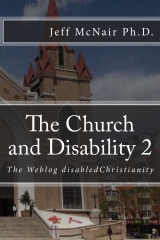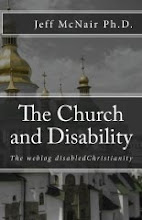Universal design is a recently developed principle. It is defined by The Center for Universal Design as, "The design of products and environments to be usable by all people, to the greatest extent possible, without the need for adaptation or specialized design." If you
go here, you can see one of their webpages which provides the definition as well as 7 principles with explanations.
One of the lessons of universal design, is that changes that are made, say for example in an environment, for the expressed purpose of making things easier for a disabled person, end up often benefitting everyone in that environment. This is illustrated in the webpage provided above.
I was thinking through the universal design principle the other day, and it occurred to me that universal design should be a basic characteristic of the Church. I suspect in its purest form, if the church were all it should be, it would be a perfect example of universal design. That is the case because the Body of Christ is comprised of people with varying abilities. The church was envisioned for humanity, so it must be designed, be comprised of structures, evidence practices, develop programs, that reflect the variety of humanity. The degree to which we do not see universal design principles within the church, in many ways is evidence that it is not all that it should be. Lets consider the principles of universal design briefly in reference to the church.
1. Principle one: Equitable use
Provide the same means of use for all users: identical whenever possible; equivalent when not.
Avoid segregating or stigmatizing any users. (
UD webpage)
The church should facilitate equitable use. That means access to the programs of the church, all the benefits of church participation. The implication therefore is that programs and benefits might have to be altered such that all people can have access to them. If there is not access, the person is not wrong, the program is wrong or needs to be altered in some way. Wheelchair use should not mean that I cannot be a youth leader.
Programs and practices of the church should also not segregate and stigmatize people, particularly on the basis of perceived negative characteristics. Downs syndrome does not mean that I cannot be in the Sunday school class.
2. Principle two: Flexibility in use
Provide choice in methods of use.
Facilitate the user's accuracy and precision.
Provide adaptability to the user's pace. (
UD webpage)
Flexibility implies flexibility in the delivery of information, in the social standards (no I am not talking about sin, I am talking about social skills). By understanding "users" we understand that responses can be very different. We understand, for example, that faith development is a process that is not exclusively knowledge based, so that programs that facilitate faith development are sensitive to where people are in their faith, and the contribution of knowledge to faith develoment. We also do not offer "once size fits all" worship, or Sunday school, or music. We may find that people will prefer the faith development activities designed for persons with intellectual disabilities, for example, because they are connected with real life and are less potentially esoteric. Worship alongside of a person who is atypical changes the nature of worship from quiet listening to a sermon, to service, or patient love, or a variety of other goods. Do we ever assess user's pace in sermon delivery? Do we ever assess faith development in individuals who have listened to sermon's for 20 years as a means to evaluate our programs? Sometimes I feel like if I am not understanding something that has become programmatically entrenched in the way the church has always done things, that I am at fault. But it may not be so. Universal design would say that there are others who have the same questions as I, but the programmatic "heavy hand" squelches questions of why.
3. Principle three: Simple and intuitive
Eliminate unnecessary complexity.
Be consistent with user expectations and intuition.
Accommodate a wide range of literacy and language skills.
Arrange information consistent with its importance.
Provide effective prompting and feedback during and after task completion. (
UD webpage)
Are programs of the church simple and intuitive? I know that often in programs for persons with intellectual disabilities, the knowledge based orientation of the programs makes them unnecessarily complex. Somehow complexity is a high value in knowledge based approaches. But what are the user expectations of the typical church member? Are they being addressed and do we even know whether or not they are?
I have often wondered about the way church programs accommodate literacy skills (let alone language skills). How do we make material accessible in a manner that is not demeaning for those for whom literacy is an issue?
I have also wondered about the notion of arranging information consistent with its importance. In training persons with severe disabilities, there is the concept of functional curriculum. That is, teachers ask themselves whether it will make any difference in the person's life if they learn a particular thing. This notion is something that churches should consider in program development. Do we ever evaluate the comparative importance of the information we are sharing or do we just blindly teach our 3rd grade Sunday school class? I remember looking through a children's picture Bible, where there was a picture of Absolom hanging by his hair from a tree! What is the point of this in terms of importance of relevance of the story to children?
Once something is learned, how to we ensure learning is maintained, or do we simply move onto the next thing?
4. Principle four: Perceptible information
Use different modes (pictorial, verbal, tactile) for redundant presentation of essential information.
Provide adequate contrast between essential information and its surroundings. (
UD webpage)
How do we make relevant information perceptable, and how do we help people to understand what is relevant? Do we highlight or point out for people that this is the focus, this is the lesson, and how do we facilitate understanding?
In our current churches, we have lots of video and lots of music, etc. Is that the way to make specific content relevant because there is a difference between being culturally relevant (via technology for example) and personally relevant in terms of helping people understand what is essential. The video screens are not essential, although they may assist in bringing what is essential to the notice of those viewing. I am confident, however, that there is confusion about whether the information or the video screens are what is essential to many people.
5. Principle five: Tolerance for error
Arrange elements to minimize hazards and errors: most used elements, most accessible; hazardous elements eliminated, isolated, or shielded.
Provide warnings of hazards and errors.
Provide fail safe features.
Discourage unconscious action in tasks that require vigilance. (
UD webpage)
What hazards or errors might characterize a church that is trying to include people with disabilities? In the past hazards and errors have been the focus on social skills of attendees, on the potential perceive contribution of attendees, on the demands people by virtue of their disabilities may make on attendees, the failure of leadership in recognizing the priority that should be place on ministry that involves service. Past errors have also been related to resistance to change.
People might also need to be prepared to see errors within themselves so that they can be aware of them. "We are going to have people start coming here who are autistic. Autistic people sometimes make strange noises that largely will make us feel uncomfortable, because we have not been around them enough to have their noises no longer bother us. But we will get better over time as we become acclimated to them and them to us. What we cannot do is reject them, because that is sin and we don't want to sin."
6. Principle six: Low physical effort
Allow user to maintain a neutral body position.
Use reasonable operating forces.
Minimize repetitive actions.
Minimize sustained physical effort. (
UD webpage)
How can the effort to do church attendance be minimized for persons with disabilities? Whether it be not having to ride the bus to church, or just getting around? We also need to teach average church members the truth, biblically and theologically about what disability is so that they do not cause the goofy ideas that have grown out of ignorance to persist. I know of people with disabilities who will not go back to church because of the things said to them there. Things about sin and disability or sufficient faith and disability, or just a blatant lack of understanding of what life is like for a person with a disability. I will also say that many people, church people, Christian people who use the handicapped parking spots should be ashamed. I literally know of people who have come to a church, but did not stay because all of the handicapped parking spots were used. You might say, "You should be celebrating that! All the spots are filled." Yeah, but I see the mirror hangers that someone holds onto from the broken leg they had a year ago and that isn't right.
7. Principle seven: Size and space for approach and use
Provide a clear line of sight to important elements for any seated or standing user.
Make reach to all components comfortable for any seated or standing user.
Accommodate variations in hand and grip size.
Provide adequate space for the use of assistive devices or personal assistance. (
UD webpage)
People should have access to what they need at a church, whether it be physical, intellectual, or emotional. I was speaking to a friend the other day with a hearing impairment. He asked the church whether they could provide an interpreter so he could attend Bible study, and they said they couldn't. But then he asked whether there was someone who could disciple him, teach him the Bible one on one, because he can understand one person at a time in a one on one conversation and they once again said no. That is just stupid. One on one is called discipleship and churches do that all around the world. His church was blocking his access to God's word because they would not facilitate approach.
So much more could be said on these points, however, I think the take home lesson, is that the Christian church should strive to be the model of universal design. It should be the example that people use whenever they discuss such principles. I believe that it is God's intention that the church be a place of openness and acceptance. A supple place where the environment is much softer than the community. Where people come and can cease their fighting and relax in love acceptance and accommodations as appropriate. A place that does not nullify the word of God by its traditions (Mark 7:13).
McNair










